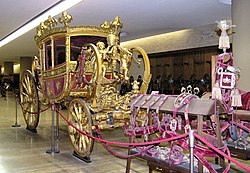
Vatican City, officially the Vatican City State, is a landlocked independent country, city-state, microstate, and enclave within Rome, Italy. It became independent from Italy in 1929 with the Lateran Treaty, and it is a distinct territory under "full ownership, exclusive dominion, and sovereign authority and jurisdiction" of the Holy See, itself a sovereign entity under international law, which maintains the city state's temporal power and governance, diplomatic, and spiritual independence. With an area of 49 hectares and as of 2023 a population of about 764, it is the smallest state in the world both by area and population. As governed by the Holy See, Vatican City State is an ecclesiastical or sacerdotal-monarchical state ruled by the Pope who is the bishop of Rome and head of the Catholic Church. The highest state functionaries are all Catholic clergy of various origins. After the Avignon Papacy (1309–1377) the popes have mainly resided at the Apostolic Palace within what is now Vatican City, although at times residing instead in the Quirinal Palace in Rome or elsewhere. The Vatican is also a metonym for the Holy See.
The Vatican City State is a neutral nation, which has not engaged in any war since its formation in 1929 by the Lateran Treaty. It has no formal military compact or agreement with neighbouring Italy, although responsibility for defending the Vatican City from an international aggressor is likely to lie primarily with the Italian Armed Forces. When presenting the Lateran Treaty to the Italian parliament in 1929, Benito Mussolini declared: "It is evident that we [the Italian state] will be the necessary guarantors of this neutrality and inviolability [of Vatican City], since, in the remote hypothesis someone wanted to hurt her, he would first have to violate our territory." Although the Vatican City State has never been at war, its forces were exposed to military aggression when it was bombed during World War II, and whilst defending Vatican property in Rome during the same conflict.
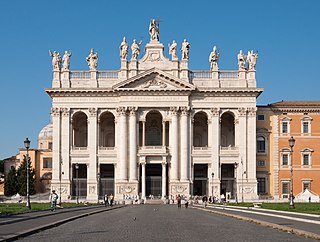
The Archbasilica Cathedral of the Most Holy Savior and of Saints John the Baptist and John the Evangelist in the Lateran is the Catholic cathedral church of the Diocese of Rome in the city of Rome, and serves as the seat of the bishop of Rome, the pope. The archbasilica lies outside of Vatican City proper, which is located approximately 4 kilometres (2.5 mi) to the northwest. Nevertheless, as properties of the Holy See, the archbasilica and its adjoining edifices enjoy an extraterritorial status from Italy, pursuant to the terms of the Lateran Treaty of 1929. Dedicated to the Christ, John the Baptist and John the Evangelist, the place name, Laterano (Lateran) comes from an ancient Roman family (gens), whose palace (domus) grounds occupied the site; the adjacent Lateran Palace was the primary residence of the pope until the Middle Ages.

The Vatican Museums are the public museums of Vatican City. They display works from the immense collection amassed by the Catholic Church and the papacy throughout the centuries, including several of the most well-known Roman sculptures and most important masterpieces of Renaissance art in the world. The museums contain roughly 70,000 works, of which 20,000 are on display, and currently employ 640 people who work in 40 different administrative, scholarly, and restoration departments.
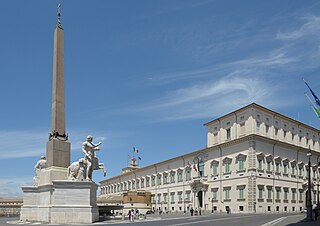
The Quirinal Palace is a historic building in Rome, Italy, one of the three current official residences of the President of the Italian Republic, together with Villa Rosebery in Naples and the Tenuta di Castelporziano, an estate on the outskirts of Rome, some 25 km from the centre of the city. It is located on the Quirinal Hill, the highest of the seven hills of Rome in an area colloquially called Monte Cavallo. It has served as the residence for thirty popes, four kings of Italy and twelve presidents of the Italian Republic.

The Apostolic Palace is the official residence of the pope, the head of the Catholic Church, located in Vatican City. It is also known as the Papal Palace, the Palace of the Vatican and the Vatican Palace. The Vatican itself refers to the building as the Palace of Sixtus V, in honor of Pope Sixtus V, who built most of the present form of the palace.

The Vatican Apostolic Library, more commonly known as the Vatican Library or informally as the Vat, is the library of the Holy See, located in Vatican City, and is the city-state's national library. It was formally established in 1475, although it is much older—it is one of the oldest libraries in the world and contains one of the most significant collections of historical texts. It has 75,000 codices from throughout history, as well as 1.1 million printed books, which include some 8,500 incunabula.

The Lateran Palace, formally the Apostolic Palace of the Lateran, is an ancient palace of the Roman Empire and later the main papal residence in southeast Rome.
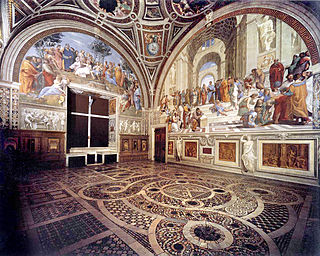
The four Raphael Rooms form a suite of reception rooms in the Apostolic Palace, now part of the Vatican Museums, in Vatican City. They are famous for their frescoes, painted by Raphael and his workshop. Together with Michelangelo's Sistine Chapel ceiling frescoes, they are the grand fresco sequences that mark the High Renaissance in Rome.
The Lateran Museum was a museum founded by the Popes and housed in the Lateran Palace, adjacent to the Archbasilica of Saint John Lateran in Rome, Italy. It ceased to exist in 1970.
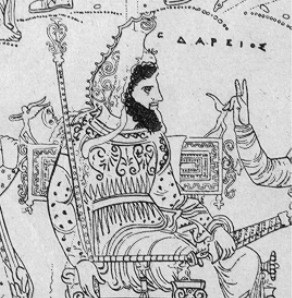
The origins of the papal tiara remain somewhat nebulous and clouded in mystery, first appearing in the Early Middle Ages, but developing a recognizable form in the High Middle Ages, after the Great Schism of 1054. The word tiara itself occurs in the classical annals to denote a Persian headdress, particularly that of the "great king". A camelaucum which was similar in shape to papal tiaras, was part of court dress in Byzantium; it was also inspired by the Phrygian cap, or frigium. Given that other rituals associated with the papal coronation, notably the use of the sedia gestatoria, were copied from Byzantine and eastern imperial ceremonial, it is likely that the tiara is also of Byzantine origin.
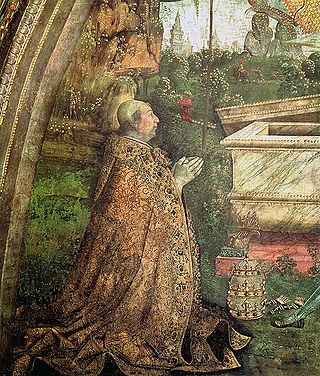
The Borgia Apartments are a suite of rooms in the Apostolic Palace in the Vatican, adapted for personal use by Pope Alexander VI. In the late 15th century, he commissioned the Italian painter Bernardino di Betto (Pinturicchio) and his studio to decorate them with frescoes.
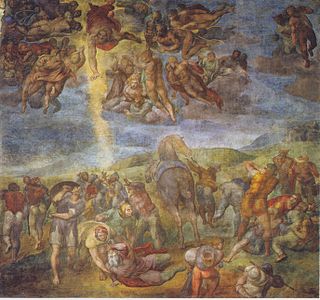
The Cappella Paolina is a chapel in the Apostolic Palace, Vatican City. It is separated from the Sistine Chapel by the Sala Regia. It is not on any of the regular tourist itineraries.

The Disputation of the Sacrament, or Disputa, is a painting by the Italian Renaissance artist Raphael. It was painted between 1509 and 1510 as the first part of Raphael's commission to decorate with frescoes the rooms that are now known as the Stanze di Raffaello, in the Apostolic Palace in the Vatican. At the time, this room was known as the Stanza della Segnatura, and was the private papal library where the supreme papal tribunal met.

The Baptism of Constantine is a painting by assistants of the Italian Renaissance artist Raphael. It was most likely painted by Gianfrancesco Penni, between 1517 and 1524.

Cesare Nebbia (c.1536–c.1614) was an Italian painter from Orvieto who painted in a Mannerist style.

The Vatican Railway was opened in 1934 to serve Vatican City and its only station, Vatican City. The main rail tracks are standard gauge and 300 metres (980 ft) long, with two freight sidings, making it the shortest national railway system in the world. Access to the Italian rail network is over a viaduct to Roma San Pietro railway station, and is guaranteed by the Lateran Treaty dating from 1929. The tracks and station were constructed during the reign of Pope Pius XI, shortly after the treaty.
This is an index of Vatican City–related topics.

The Museo Storico Nazionale dell'Arte Sanitaria is located within the Ospedale di Santo Spirito in Sassia at 3, Lungotevere in Sassia in Rome (Italy).

The Museum of the Liberation of Rome is located in an apartment building at Via Tasso 145, Rome, close to the basilica of St. John Lateran. It records the period of German occupation of Rome in the Second World War and its subsequent liberation. The building housing the museum was used by the SS to torture members of the Italian Resistance in the first half of 1944.
